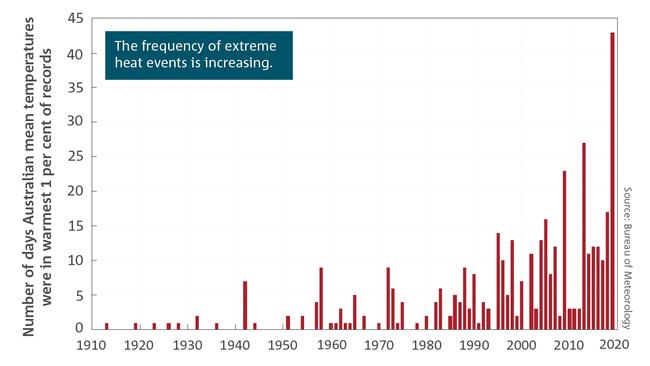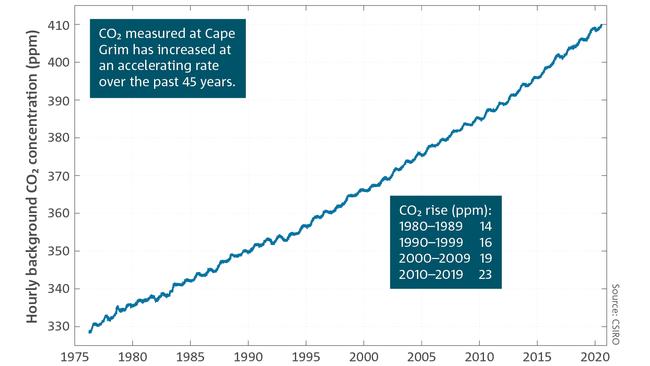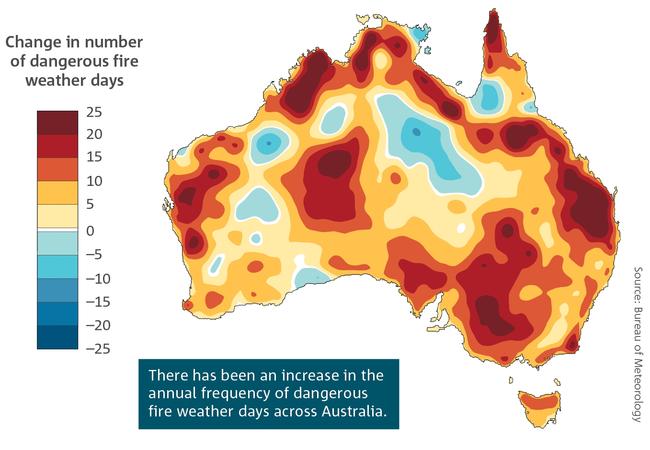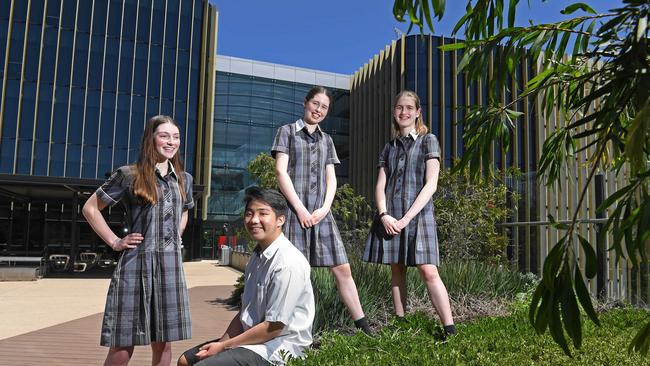CSIRO and BOM release State of the Climate 2020 report, shows Australia has warmed 1.5C since 1910
On 33 days last year, all of Australia’s maximum average temperature was over 39C. That’s more days than in the previous 58 years combined.
SA News
Don't miss out on the headlines from SA News. Followed categories will be added to My News.
The catastrophic fire season of last spring and summer will be more common as Australia warms, making the hottest year on record seem cool by comparison, the CSIRO says.
The State of the Climate 2020 report, released today by CSIRO and the Bureau of Meteorology, shows Australia has already warmed by almost 1.5C since national records began in 1910.
Every two years the report reveals the latest observations and trends in temperature and rainfall through to sea level rise and ocean acidification.
It shows the country had 43 extremely warm days in 2019, more than triple the number it experienced in any year before 2000. It reveals 2019 was Australia’s hottest year on record, with 33 days in which the national daily maximum average temperature exceeded 39C.
This total number of extremely hot days is “more than the number observed from 1960 to 2018 combined, which totalled 24 days,” the report states.

Dr Karl Braganza, from the Bureau of Meteorology, said there had also been a “significant increase in the frequency of dangerous fire-weather days across Australia, particularly during spring and summer, leading to an earlier start to the southern fire season.”
CSIRO Climate Science Centre director Dr Jaci Brown said the report provides a “sobering look ahead”.
“Ten to 20 years from now, 2019 won’t be unusual, in fact, we think of this decade being hot, but this decade will be one of the coolest in the next hundred years,” Dr Brown said.
This summer will be cooler than the last, but Dr Brown said that was “because we tend to get a dip in temperatures with La Nina”.
This year also was marked by the COVID-19 pandemic, which caused a global decline in fossil fuel emissions of the greenhouse gas carbon dioxide or CO2, but this had “negligible impact” on climate change overall.
Atmospheric CO2 levels continued to rise and fossil fuel emissions remained the principal driver of this growth.
“Another way to think about this is if you’ve been eating junk food for 10 years and then you go on a diet for one day, and you jump on the scales the next morning expecting to see some change, drop a dress size, it’s not that simple,” Dr Brown said.
“This is about a very long-term change, so I think the big challenge for our children and grandchildren will be how to flatten this curve.”

The Cape Grim Baseline Air Pollution Station in northwest Tasmania is a key site in the World Meteorological Organisation’s Global Atmosphere Watch program.
Dr Brown emphasised the importance of maintaining this station along with the other monitoring systems we have in place, in the face of cost-saving measures.
“We need to keep that record going and when we do get to see more mitigation, we need to be able to measure what impact that has, to know how things are changing,” she said.
“Also on the broader scale, not just over Australia, how fast the ice is melting, how fast the global heat content is changing. That gives us that heads up of what we’re expecting over the next decades.”
The report reveals Australia has warmed on average by 1.44C, give or take 0.24C, which is far more specific than the 1C figure in the last report.
Most warming has occurred since 1950 and every decade since then has been warmer than the ones before.
The seven years from 2013 to 2019 all rank in the nine warmest years. Warming is observed in all months, day and night. Along with warming comes more frequent extreme events including bushfires.
The Forest Fire Danger Index combines temperature, rainfall, humidity and wind speed. Using this index to map the change in the number of dangerous fire days between two periods – July 1950 to June 1985, and July 1985 to June 2020 – shows South Australia is among the hardest hit by fierce fire conditions now. This trend will continue.

Rainfall steady, but river is drying
South Australia has so far been spared the worst of the drying trend across southern Australia, the Bureau of Meteorology says.
In the State of the Climate report 2020, the heat map showing how April to October rainfall has changed over the past 20 years, compared with the average, reveals our state fared far better than the southwest of Western Australia or large parts of New South Wales, Victoria and Queensland.

Climate Environmental Prediction Services manager Dr Karl Braganza said the story for SA is a little more “equivocal”.
“It’s probably the southeast of the state where you’re going to see the largest impacts from drying, particularly from a reduction in rainfall from westerly-driven weather systems, so those cold fronts and flows that come across the continent,” he said.
There’s also an “emerging signal of heavier rainfall when the conditions are right, instances where there’s quite a lot of moisture in the atmosphere over southeast South Australia bringing very heavy rainfall events”.
Those heavy downpours, especially in the warmer months, can cause localised flooding. But in general, streamflow from rainfall has reduced.
In the Murray-Darling Basin, most of the streamflow gauges show a declining trend since records began in 1970.
Changing rainfall patterns mean the country as a whole, and the basin in particular, is generally wetter in the north and drier in the south, but warmer temperatures and higher evaporation means streamflow has been reduced in three quarters of stations.
Youth ideas to fix planet they will be left with
Climate change looms large on the horizon for our children, who will inherit the problem of excess greenhouse gases such as carbon dioxide warming the atmosphere, with far-reaching consequences for life on Earth.
At Adelaide Botanic High School, students are encouraged to explore the issue and find solutions.
Clementine Cooke-Hall, 14, of Fitzroy, would like to use visual arts to inspire a passion for the environment, provide creative ways to share information and raise awareness about the issues our society faces.
Hieu Nguyen, 15, of Pooraka, likes to focus on ways he can contribute personally, from the “little things like composting and recycling” through to environmentally-conscious shopping.
The Year 10 student is interested in developing new materials that can replace plastics derived from fossil fuels. He’s working on a project to design a carbon-neutral shoe, considering three billion shoes are created every year, with embodied fossil fuels. He also wants to hold nations accountable for emissions.

Sasha Saulwick, 15, of Payneham, would also like to see greater diversity in politics, including people from different cultural backgrounds and better gender balance.
“Privilege clouds our judgment,” she said.
“First-Nation knowledge is super important because they have worked in conjunction with nature for so many years.”
The Year 10 student wants to study environmental science at university.
“I want to focus on the practical side of things, going into communities, helping with rural areas,” Ms Salulwick said.
“There are so many solutions out there, amazing science and research, even things we haven’t thought about or heard about yet. When there’s a need, for something to happen, things do change.”
Olivia Turner, 15, of Prospect, is calling for legislative change in the transition away from fossil fuels, foster environmentally friendly buildings and no more coal mines.
She believes young people should be more involved.
“Big changes need to be made but small steps, frequently, can be taken to achieve those changes,” she said.
“People need to feel comfortable and not like their whole world is being tipped upside down.”





